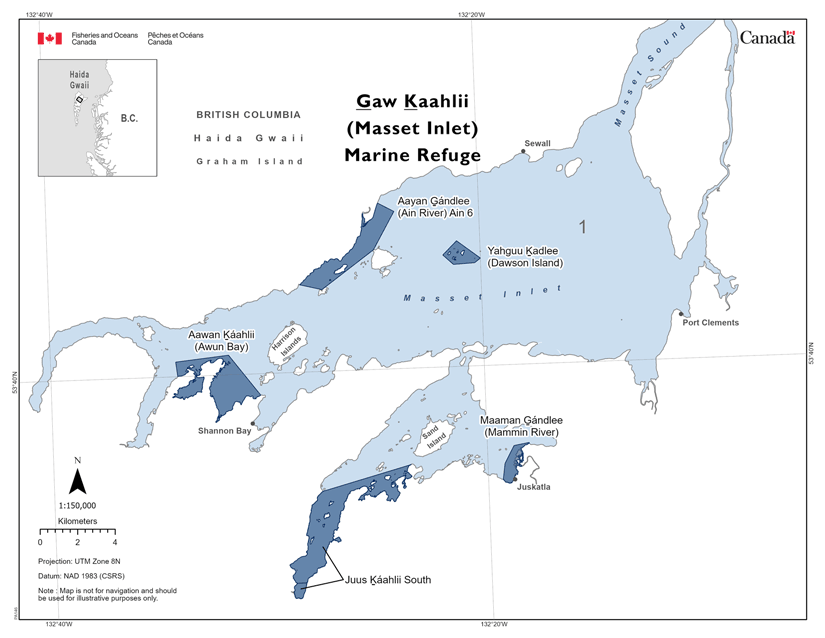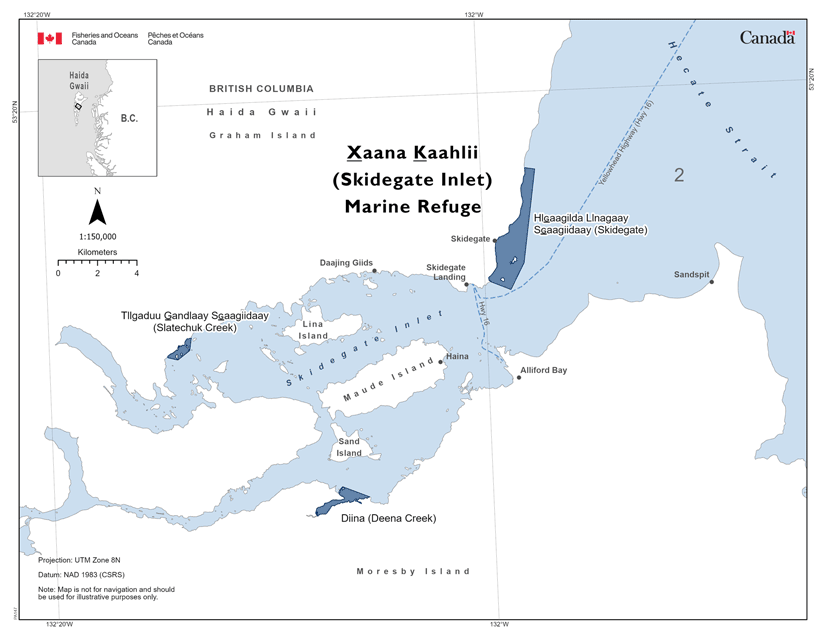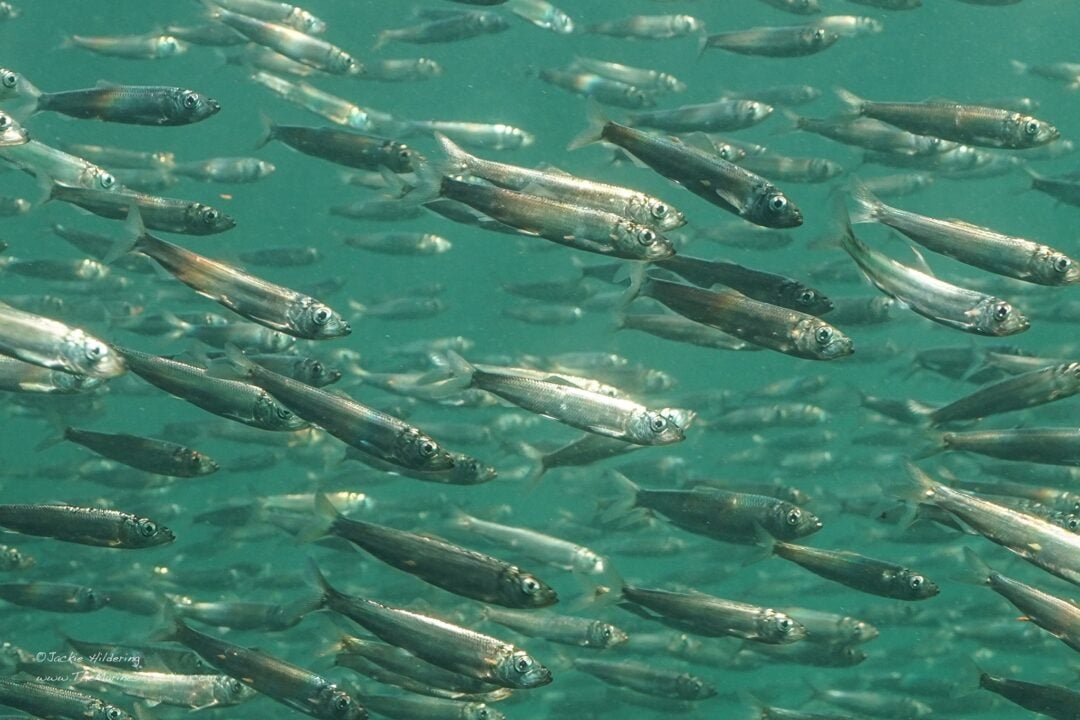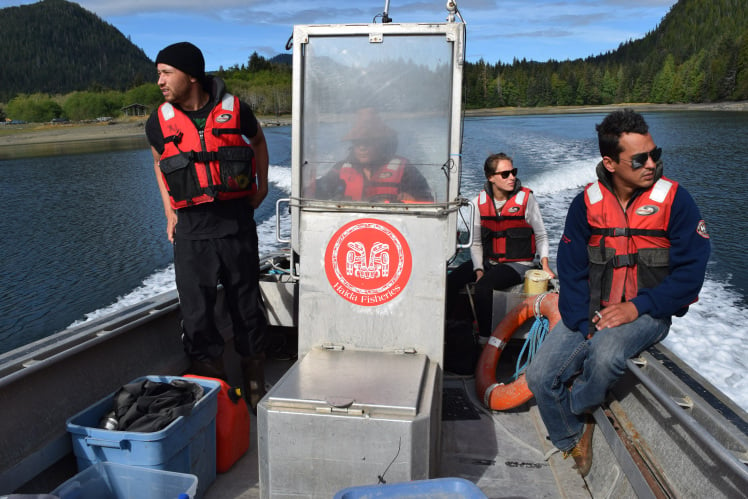In a move that marks a significant step for Indigenous-led marine conservation, three new marine refuges have been officially established along British Columbia’s North Coast under the Great Bear Sea Project Finance for Permanence initiative.
Collaborating to Rebuild Fish Stocks
Designated under the Fisheries Act, marine refuges are long-term fisheries-area closures established to protect important species, habitats, and ecosystems. These refuges are recognized as “Other Effective Area-Based Conservation Measures” (OECMs) for their role in safeguarding the marine food web.
Led in partnership by the federal government and the Haida and Gitxaała First Nations, these refuges aim to enhance coastal abundance by protecting critical habitats for a range of marine species, including salmon, herring, rockfish, and seabird populations. The protected areas will create the foundation for sustainable fisheries, while also marking a deeper commitment to reconciliation and Indigenous-led marine conservation on BC’s coast.
Haida Nation’s G̱aw K̲áahlii and X̲aana K̲aahlii Marine Refuges

G̱aw Ḵáahlii (Masset Inlet) is home to salmon estuaries, kelp beds, herring spawning grounds, and killer whale habitat. It is also an important region for many migratory bird species. Photo credit: The Government of Canada

X̲aana K̲aahlii (Skidegate Inlet) is rich with life—its eelgrass beds support migratory bird species and are nesting sites for many marine birds. Photo credit: The Government of Canada
The President of the Haida Nation, Gaagwiis Jason Alsop, and the Minister of Fisheries, Joanne Thompson, announced the official designation of two co-governed marine refuges in Haida Gwaii, G̱aw Ḵáahlii and X̲aana K̲aahlii, on October 17.
According to the Haida Nation, the establishment of the G̱aw K̲áahlii and X̲aana K̲aahlii Marine Refuges builds upon nearly two decades of Haida-led marine planning efforts across Haida Gwaii. The refuges complement the ongoing implementation of the Haida Gwaii Marine Plan and advance the objectives of the Great Bear Sea Marine Protected Area (MPA) Network, of which they are a part.
“These inlets support a rich diversity of life, including all species of salmon, herring, and many others that are important for Haida and local food security.”
Gaagwiis Jason Alsop, President of the Haida Nation
Together, the two new marine refuges in Haida Gwaii cover nearly 30 square kilometres of ocean. The G̱aw Ḵáahlii Marine Refuge spans 22.42 km², while the X̲aana K̲aahlii Marine Refuge adds another 7.16 km² — a combined 29.58 km² contributing to Canada’s national marine conservation targets. These areas will be co-managed by the Haida Nation Council and Fisheries and Oceans Canada.
“G̲aw K̲áahlii and X̲aana K̲aahlii hold great significance to the Haida Nation. Guided by knowledge shared by Elders and knowledge holders during the Haida Marine Traditional Knowledge Study, G̲aw K̲áahlii and X̲aana K̲aahlii were identified as key areas to protect,” said Alsop in a statement.
According to Alsop, “These inlets support a rich diversity of life, including all species of salmon, herring, and many others that are important for Haida and local food security.”
The sustainable marine management approach developed to safeguard this diversity is informed by Haida traditional knowledge and marine-use planning. The foundation of this approach is restoring abundance by protecting critical habitat, such as nurseries and feeding grounds, so salmon, herring, and rockfish stocks can naturally repopulate surrounding fishery zones.
“G̲aw K̲áahlii Marine Refuge will protect essential stopover habitat for many migratory birds, including Western Sandpipers, as well as killer whales, salmon, and other marine life that rely on the inlet.”
Dr. Jeff Wells, Vice President of Audubon’s Canada Program
Alsop stated the designations help fulfill the responsibility of ensuring “future generations are able to continue to enjoy the bounties of the ocean.” These refuges are not about conservation for conservation’s sake. Instead, they have been designed and will be managed to create abundance, resulting in sustainable local fisheries for generations to come.
This sentiment is reflected by Dr. Jeff Wells, vice president of Audubon’s Canada program: “G̲aw K̲áahlii Marine Refuge will protect essential stopover habitat for many migratory birds, including Western Sandpipers, as well as killer whales, salmon, and other marine life that rely on the inlet. The establishment of both marine refuges is a huge win for the Haida Nation and will benefit an abundance of wildlife for generations to come.”
Gitxaała Nation’s Banks Marine Refuge

In a separate announcement, Chief Councillor Linda Innes of Gitxaała Nation and Fisheries Minister Joanne Thompson announced the establishment of the 436-square-kilometre Banks Marine Refuge, a new protected area in Nłuut’iksgm Laxyuubm Gitxaała (sacred Gitxaała Territory) on the north coast of British Columbia.
This refuge safeguards ancient coral gardens, eelgrass beds, and kelp forests that serve as spawning and rearing habitats for rockfish, prawn, salmon, and other important species by restricting prawn and crab trap fisheries and tightening rockfish closures. The result is nearshore rebuilding zones where fish stocks recover, supporting future harvests.
“It is about responsible stewardship now, so that coastal communities and future generations can count on healthy waters tomorrow.”
Joanne Thompson, Minister of Fisheries
Linda Innes, elected chief councillor of the Gitxaała Nation, underscored the significance of the agreement, saying it demonstrates what can be achieved when Canada works with Gitxaała “in a respectful and principled way.” She added that the Banks Marine Refuge represents “a step toward abundance, rooted in our stewardship responsibilities and Gitxaała Adaawx, Ayaawx, and Gugwilx’ya’ansk,” and contributes to the wider MPA Network in a way that upholds Gitxaała leadership.
Joanne Thompson said the agreement reflects the deep connection between marine protection and reconciliation. “Protecting our marine environment goes hand-in-hand with advancing reconciliation. Working with the Gitxaała Nation, this step under the Great Bear Sea Project Finance for Permanence strengthens protection for a unique ecosystem and the livelihoods it supports,” she said. “It is about responsible stewardship now, so that coastal communities and future generations can count on healthy waters tomorrow.” It is responsible stewardship that creates abundance, resulting in sustainable fisheries for future generations.

As with the two protected areas in Haida Gwaii, this refuge’s focus is on rebuilding fish stocks, maintaining a strong marine food web, fostering abundance, and establishing the conditions for long-term, sustainable local fisheries.
These priorities directly coincide with the goals of the broader Great Bear Sea Marine Protected Area (MPA) Network, which, according to Heiltsuk Chief Councillor and president of Coastal First Nations K`áwáziɫ (Marilyn Slett), includes “bring(ing) the resources back into abundance” and “sustain(ing) the economy into the future.”
“When both parties are heard and respected, we can meet shared goals.”
Linda Innes, Chief Councillor of Gitxaała Nation
Linda Innes underscored the historic nature of the agreement, noting that “when both parties are heard and respected, we can meet shared goals.”





